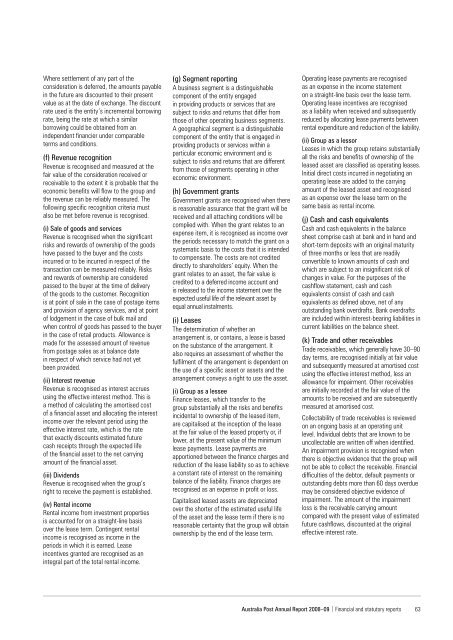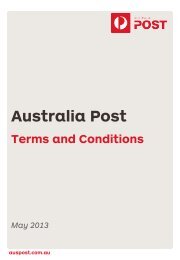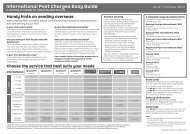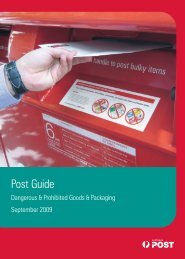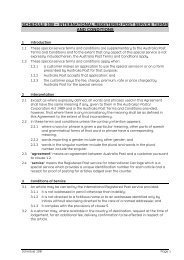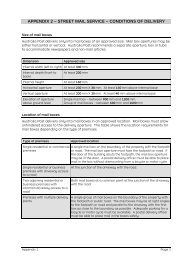Australia Post Annual Report 2008–09
Australia Post Annual Report 2008–09
Australia Post Annual Report 2008–09
You also want an ePaper? Increase the reach of your titles
YUMPU automatically turns print PDFs into web optimized ePapers that Google loves.
Where settlement of any part of the<br />
consideration is deferred, the amounts payable<br />
in the future are discounted to their present<br />
value as at the date of exchange. The discount<br />
rate used is the entity’s incremental borrowing<br />
rate, being the rate at which a similar<br />
borrowing could be obtained from an<br />
independent financier under comparable<br />
terms and conditions.<br />
(f) Revenue recognition<br />
Revenue is recognised and measured at the<br />
fair value of the consideration received or<br />
receivable to the extent it is probable that the<br />
economic benefits will flow to the group and<br />
the revenue can be reliably measured. The<br />
following specific recognition criteria must<br />
also be met before revenue is recognised.<br />
(i) Sale of goods and services<br />
Revenue is recognised when the significant<br />
risks and rewards of ownership of the goods<br />
have passed to the buyer and the costs<br />
incurred or to be incurred in respect of the<br />
transaction can be measured reliably. Risks<br />
and rewards of ownership are considered<br />
passed to the buyer at the time of delivery<br />
of the goods to the customer. Recognition<br />
is at point of sale in the case of postage items<br />
and provision of agency services, and at point<br />
of lodgement in the case of bulk mail and<br />
when control of goods has passed to the buyer<br />
in the case of retail products. Allowance is<br />
made for the assessed amount of revenue<br />
from postage sales as at balance date<br />
in respect of which service had not yet<br />
been provided.<br />
(ii) Interest revenue<br />
Revenue is recognised as interest accrues<br />
using the effective interest method. This is<br />
a method of calculating the amortised cost<br />
of a financial asset and allocating the interest<br />
income over the relevant period using the<br />
effective interest rate, which is the rate<br />
that exactly discounts estimated future<br />
cash receipts through the expected life<br />
of the financial asset to the net carrying<br />
amount of the financial asset.<br />
(iii) Dividends<br />
Revenue is recognised when the group’s<br />
right to receive the payment is established.<br />
(iv) Rental income<br />
Rental income from investment properties<br />
is accounted for on a straight-line basis<br />
over the lease term. Contingent rental<br />
income is recognised as income in the<br />
periods in which it is earned. Lease<br />
incentives granted are recognised as an<br />
integral part of the total rental income.<br />
(g) Segment reporting<br />
A business segment is a distinguishable<br />
component of the entity engaged<br />
in providing products or services that are<br />
subject to risks and returns that differ from<br />
those of other operating business segments.<br />
A geographical segment is a distinguishable<br />
component of the entity that is engaged in<br />
providing products or services within a<br />
particular economic environment and is<br />
subject to risks and returns that are different<br />
from those of segments operating in other<br />
economic environment.<br />
(h) Government grants<br />
Government grants are recognised when there<br />
is reasonable assurance that the grant will be<br />
received and all attaching conditions will be<br />
complied with. When the grant relates to an<br />
expense item, it is recognised as income over<br />
the periods necessary to match the grant on a<br />
systematic basis to the costs that it is intended<br />
to compensate. The costs are not credited<br />
directly to shareholders’ equity. When the<br />
grant relates to an asset, the fair value is<br />
credited to a deferred income account and<br />
is released to the income statement over the<br />
expected useful life of the relevant asset by<br />
equal annual instalments.<br />
(i) Leases<br />
The determination of whether an<br />
arrangement is, or contains, a lease is based<br />
on the substance of the arrangement. It<br />
also requires an assessment of whether the<br />
fulfilment of the arrangement is dependent on<br />
the use of a specific asset or assets and the<br />
arrangement conveys a right to use the asset.<br />
(i) Group as a lessee<br />
Finance leases, which transfer to the<br />
group substantially all the risks and benefits<br />
incidental to ownership of the leased item,<br />
are capitalised at the inception of the lease<br />
at the fair value of the leased property or, if<br />
lower, at the present value of the minimum<br />
lease payments. Lease payments are<br />
apportioned between the finance charges and<br />
reduction of the lease liability so as to achieve<br />
a constant rate of interest on the remaining<br />
balance of the liability. Finance charges are<br />
recognised as an expense in profit or loss.<br />
Capitalised leased assets are depreciated<br />
over the shorter of the estimated useful life<br />
of the asset and the lease term if there is no<br />
reasonable certainty that the group will obtain<br />
ownership by the end of the lease term.<br />
Operating lease payments are recognised<br />
as an expense in the income statement<br />
on a straight-line basis over the lease term.<br />
Operating lease incentives are recognised<br />
as a liability when received and subsequently<br />
reduced by allocating lease payments between<br />
rental expenditure and reduction of the liability.<br />
(ii) Group as a lessor<br />
Leases in which the group retains substantially<br />
all the risks and benefits of ownership of the<br />
leased asset are classified as operating leases.<br />
Initial direct costs incurred in negotiating an<br />
operating lease are added to the carrying<br />
amount of the leased asset and recognised<br />
as an expense over the lease term on the<br />
same basis as rental income.<br />
(j) Cash and cash equivalents<br />
Cash and cash equivalents in the balance<br />
sheet comprise cash at bank and in hand and<br />
short-term deposits with an original maturity<br />
of three months or less that are readily<br />
convertible to known amounts of cash and<br />
which are subject to an insignificant risk of<br />
changes in value. For the purposes of the<br />
cashflow statement, cash and cash<br />
equivalents consist of cash and cash<br />
equivalents as defined above, net of any<br />
outstanding bank overdrafts. Bank overdrafts<br />
are included within interest-bearing liabilities in<br />
current liabilities on the balance sheet.<br />
(k) Trade and other receivables<br />
Trade receivables, which generally have 30–90<br />
day terms, are recognised initially at fair value<br />
and subsequently measured at amortised cost<br />
using the effective interest method, less an<br />
allowance for impairment. Other receivables<br />
are initially recorded at the fair value of the<br />
amounts to be received and are subsequently<br />
measured at amortised cost.<br />
Collectability of trade receivables is reviewed<br />
on an ongoing basis at an operating unit<br />
level. Individual debts that are known to be<br />
uncollectable are written off when identified.<br />
An impairment provision is recognised when<br />
there is objective evidence that the group will<br />
not be able to collect the receivable. Financial<br />
difficulties of the debtor, default payments or<br />
outstanding debts more than 60 days overdue<br />
may be considered objective evidence of<br />
impairment. The amount of the impairment<br />
loss is the receivable carrying amount<br />
compared with the present value of estimated<br />
future cashflows, discounted at the original<br />
effective interest rate.<br />
<strong>Australia</strong> <strong>Post</strong> <strong>Annual</strong> <strong>Report</strong> <strong>2008–09</strong> | Financial and statutory reports 63


